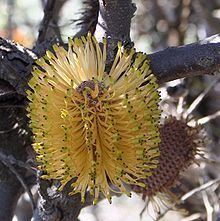Genus Banksia Rank Species | ||
 | ||
Similar Banksia caleyi, Banksia audax, Banksia benthamiana, Banksia baueri, Banksia chamaephyton | ||
The Propeller Banksia (Banksia candolleana) is a species of shrub in the plant genus Banksia. It occurs in sandplain country north of Gingin, Western Australia.
Contents
Description
Encountered as a many-branched spreading shrub 0.5–1.3 m (20–51 in) high and 2.5 m (8.2 ft) wide, Banksia candolleana has linear leaves 15–40 cm (6–15.5 in) long and 0.6–2 cm wide. The leaves are green and shiny with deep triangular lobed margins. Appearing from April to July (autumn to winter), the squat inflorescences arise on short lateral branchlets and are golden yellow in colour. Ovoid in shape, they are 5.5–7.5 cm wide. As the flower spikes age, they turn to grey and 1–5 large follicles develop.
Taxonomy
Banksia candolleana was first described by Swiss botanist Carl Meissner in 1855, after being collected by James Drummond. Its species name honours Meissner's countryman Augustin Pyramus de Candolle.
Distribution and habitat
Banksia candolleana is found from Arrowsmith south to Gingin on sandplains north of Perth. The annual rainfall is 600–700 mm.
Ecology
Banksia candolleana regenerates from a woody lignotuber after bushfire. Some large shrubs have been estimated at 1,000 years old. The white-tailed dunnart ( Sminthopsis granulipes) has been recorded visiting flowerheads, though whether it is an effective pollinator is unknown. Ants and bees, including the European Honeybee, have been recorded visiting flower spikes.
Cultivation
Banksia candolleana is slow growing in cultivation and may take up to 10 years to flower from seed. It grows readily in well-drained soils in Mediterranean climates, but does not do well in climates of higher humidity on the east coast of Australia. Seeds do not require any treatment, and take 22 to 35 days to germinate.
